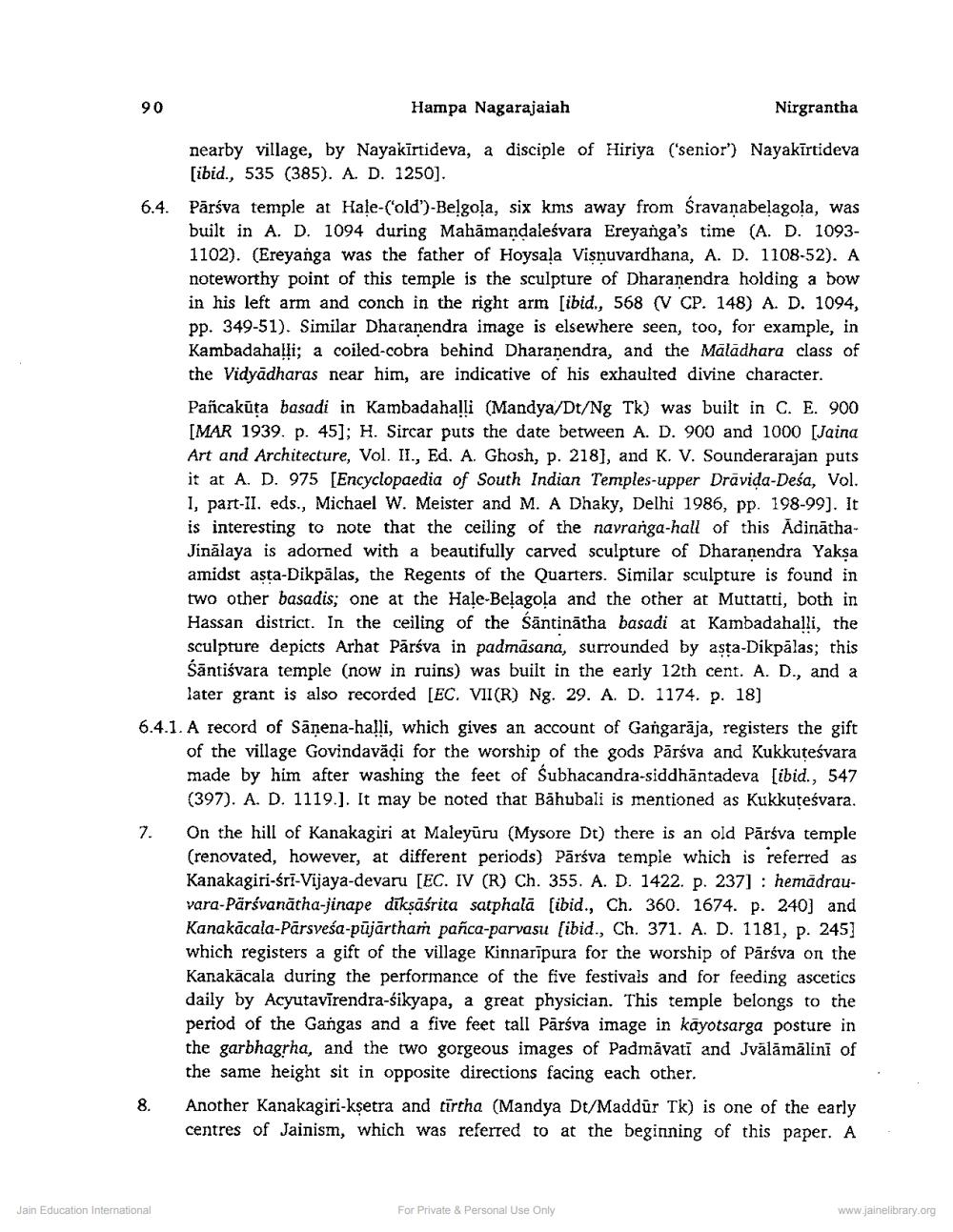Book Title: Jin Parsva and His Temples in Inscriptions of Karnataka Author(s): Hampa Nagrajaiha Publisher: Z_Nirgrantha_1_022701.pdf and Nirgrantha_2_022702.pdf and Nirgrantha_3_022703.pdf View full book textPage 7
________________ 90 Hampa Nagarajaiah Nirgrantha nearby village, by Nayakīrtideva, a disciple of Hiriya ('senior) Nayakīrtideva (ibid., 535 (385). A. D. 1250). 6.4. Pārsva temple at Hale-old')-Belgola, six kms away from Śravanabelagola, was built in A. D. 1094 during Mahāmandalesvara Ereyanga's time (A. D. 10931102). (Ereyanga was the father of Hoysa!a Visnuvardhana, A. D. 1108-52). A noteworthy point of this temple is the sculpture of Dharanendra holding a bow in his left arm and conch in the right arm (ibid., 568 (V CP. 148) A. D. 1094, pp. 349-51). Similar Dharanendra image is elsewhere seen, too, for example, in Kambadahalli; a coiled-cobra behind Dharanendra, and the Maladhara class of the Vidyadharas near him, are indicative of his exhaulted divine character. Pancakūta basadi in Kambadahalli (Mandya/Dt/Ng Tk) was built in C. E. 900 (MAR 1939. p. 45); H. Sircar puts the date between A. D. 900 and 1000 [Jaina Art and Architecture, Vol. II., Ed. A. Ghosh, p. 218], and K. V. Sounderarajan puts it at A. D. 975 [Encyclopaedia of South Indian Temples-upper Dravida-Deśa, Vol. I, part-II. eds., Michael W. Meister and M. A Dhaky, Delhi 1986, pp. 198-99). It is interesting to note that the ceiling of the navranga-hall of this AdināthaJinălaya is adorned with a beautifully carved sculpture of Dharanendra Yaksa amidst asta-Dikpālas, the Regents of the Quarters. Similar sculpture is found in two other basadis; one at the Hale-Belagola and the other at Muttatti, both in Hassan district. In the ceiling of the sāntinātha basadi at Kambadahalli, the sculpture depicts Arhat Pārśva in padmāsana, surrounded by asta-Dikpālas; this Sāntiśvara temple (now in ruins) was built in the early 12th cent. A. D., and a later grant is also recorded [EC. VII(R) Ng. 29. A. D. 1174. p. 18) 6.4.1. A record of Sanena-halli, which gives an account of Gangarāja, registers the gift of the village Govindavādi for the worship of the gods Pārśva and Kukkuteśvara made by him after washing the feet of Subhacandra-siddhāntadeva (ibid., 547 (397). A. D. 1119.]. It may be noted that Bāhubali is mentioned as Kukkuteśvara. On the hill of Kanakagiri at Maleyūru (Mysore Dt) there is an old Pārsva temple (renovated, however, at different periods) Pārśva temple which is referred as Kanakagiri-śri-Vijaya-devaru [EC. IV (R) Ch. 355. A. D. 1422. p. 237] : hemadrauvara-Pärsvanātha-jinape dīksāśrita satphalā (ibid., Ch. 360. 1674. p. 240] and Kanakācala-Pārsveśa-pūjārthaṁ pañca-parvasu (ibid., Ch. 371. A. D. 1181, p. 245] which registers a gift of the village Kinnarīpura for the worship of Pārsva on the Kanakācala during the performance of the five festivals and for feeding ascetics daily by Acyutavīrendra-śikyapa, a great physician. This temple belongs to the period of the Gangas and a five feet tall Pārsva image in käyotsarga posture in the garbhagrha, and the two gorgeous images of Padmavati and Jvälāmālini of the same height sit in opposite directions facing each other. Another Kanakagiri-kşetra and tirtha (Mandya Dt/Maddūr Tk) is one of the early centres of Jainism, which was referred to at the beginning of this paper. A Jain Education International For Private & Personal Use Only www.jainelibrary.orgPage Navigation
1 ... 5 6 7 8 9 10 11 12 13 14 15 16 17 18 19 20 21 22 23
